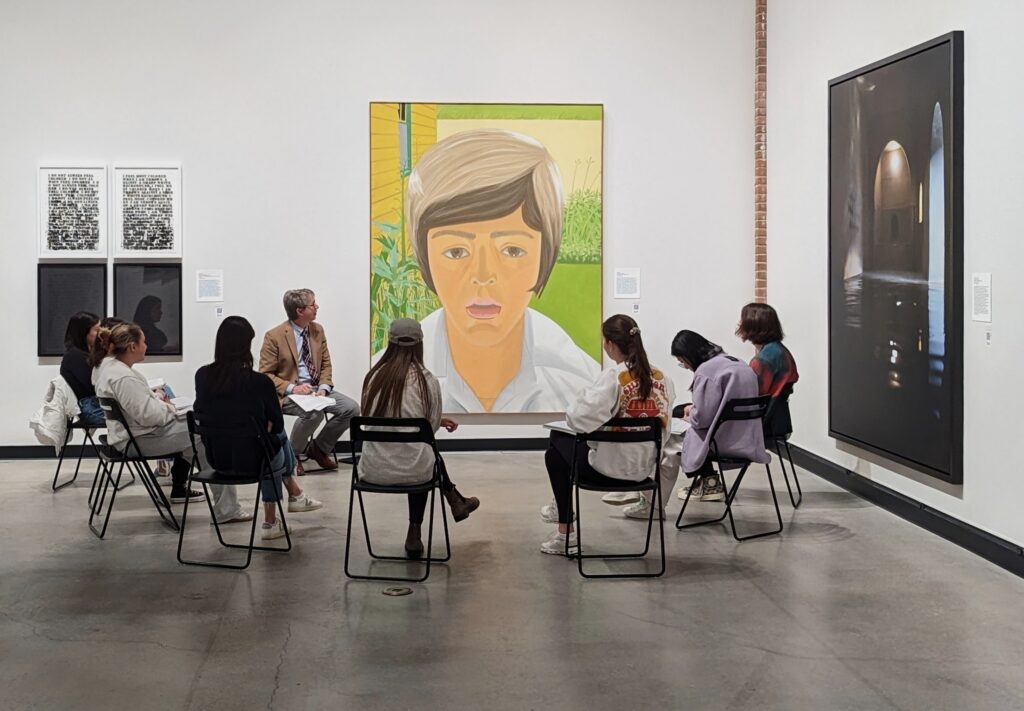Save A Day For Art

Save A Day For Art is an outreach initiative for faculty across WFU to build a day of their choice into their syllabi each semester to visit Hanes Gallery for its exhibitions and programs.
We know that within a semester there is much to cover, momentum is hard to achieve and sustain, focus on a discipline can seem paramount, and that learning outcome metrics loom.
But one of the greatest values of the liberal arts environment is that, in addition to specialized study, it creates opportunities for open, free-ranging curiosity and fosters connections between subjects as part of the student experience. At the intersection of the visual arts with other disciplines and areas of study, Hanes Gallery is uniquely positioned to offer fundamental experiential learning moments to students. As a teaching resource Hanes Gallery re-centers the Art experience within the liberal arts.
The shift from the typical classroom environment to the gallery – an intentionally distinct learning space centered on visual engagement – encourages students to return to their subjects, regardless of discipline, reenergized with different perspectives. The interactions between the students and the art presented in the gallery embody multi- and cross-disciplinary ideals.
At Hanes Gallery, we can collaborate with you as instructors to create a program, co-instruct a visit with you, have our interns provide a guided walk-through, or just have the gallery available for your class visit. Visits can be tightly programmed around the current exhibition, or function as a more open-ended context for your students. And as some of you know from your experience with gallery staff, our conversations have sometimes led to other exhibitions and opportunities for engagement.
However you conceive of your Day For Art, we are confident that almost any exhibition we present will have experiential learning and pedagogic value for your students.
Because art comes from everywhere and touches everything.
Please fill out the form below to schedule your class visit to the gallery, or for any questions, comments, or requests.
You may also contact us directly at gallery@wfu.edu
Save A Day for Art
Here is what some instructors say about including Hanes Gallery as a stop on their pedagogical itineraries:
As someone who has regularly brought my classes to the gallery, I can attest to the immense value it adds to our learning experience.
Visiting the gallery allows my students to engage with diverse artworks and perspectives outside of the traditional classroom setting. It fosters critical thinking, creativity, and dialogue, as they analyze and interpret the exhibitions in relation to our course material.
Integrating Hanes Gallery visits into my syllabus has proven to be a catalyst for deeper learning and has sparked insightful discussions among my students. I always add what I call a MUSE (Making Use of Gallery Learning Spaces) segment into my syllabus, whichever course I am teaching.
I’m thrilled to hear about the Save A Day For Art initiative and fully support the idea of incorporating visits to Hanes Gallery into syllabi. I encourage other instructors to embrace innovative, multidisciplinary approaches to teaching. The benefits extend far beyond the walls of the gallery, shaping students into more engaged and culturally aware individuals.
– Wanda Bolzano, Associate Professor, Department of English; Women’s, Gender, and Sexuality Studies
The Hanes Gallery benefits creative writing students in their coursework. My students and I are extremely lucky to have access to the Hanes Gallery and its exciting, dynamic, varied, and inspiring exhibitions.
I regularly incorporate class visits to the Hanes Gallery into my syllabi. Students read and discuss examples of literary ekphrasis, and then explore the gallery, writing in response to the art works that most speak to them. These assignments are often the best of the semester!
Synergies with the Hanes Gallery radically benefit the Creative Writing Program. We often host our events at the Hanes Gallery, particularly readings by visiting writers invited through the Dillon Johnston Writers Reading Series. Using the Hanes Art Gallery as a venue gives the writers, and attending students, faculty, and staff, an opportunity to interact with the exhibitions, and on occasion, visiting writers have shown their visual art in the gallery in conjunction with their literary readings.
– Joanna Ruocco, Associate Professor in Creative Writing; Co-Director, Dillon Johnston Writers Reading Series
It was such an organic thing to do, to use Hanes Gallery as a teaching resource.
If an instructor is unsure of how to relate their course to a gallery visit, assign the visit anyway. The students will find a connection, and the instructor may very well learn something new about the course material. That class will likely be a highlight of the semester.
The Hanes Gallery staff is marvelously helpful in helping students relate to the art. You only need to let them know ahead of time what your topic is and what you are looking for.
In addition to being a thought-provoking encounter, it can be a peaceful experience, a true fresh breeze through a constricting syllabus. Need to meet with a student? Try meeting in the Hanes Gallery for a refreshing change of pace and conversations with fascinating sidetracks.
Visiting the Hanes Gallery with a class offers a chance to explore diverse perspectives, ideas, and emotions expressed through visual mediums. It’s an opportunity for your students to be inspired, challenged, and to appreciate creativity in all its forms. The conversations begun in the gallery will likely enliven discussions for many classes to come.
– Louis Goldstein, Professor Emeritus, Music; Pianist
The Hanes Gallery is an incredible resource for students to apply classroom knowledge to a real world context. My students connect directly with artworks to apply theoretical concepts learned in class. Abstract notions of social norms, cultural values, and historical contexts are rendered in physical representation, and the Hanes staff has always been game to connect the exhibits to my course syllabus. Instead of passively listening to my lectures (at best), I see students light up with recognition, understanding, and engagement. This isn’t hyperbole – it is reflected in the comments on my end-of-semester evaluations.
– Andrew Gurstelle, Associate Teaching Professor; Academic Director of the Lam Museum of Anthropology
Taking students out of the Religious Studies classroom into Hanes Gallery has been one of my favorite ways to break open the filters created by the tight schedules of our campus lives.
The exhibitions invite a theme, a through-line of inquiry that can be threaded in unexpected ways and looped back to a syllabus through contemplative modes of inquiry.
An unscripted dialogue with color, shape, size reveals a rich entanglement of associations, emotional truths, social connections, memories, further questions. In quiet reflection and…. Immersed in the creative moment of contemplation, we become creators ourselves, speaking our lives in their layered complexities.
Wandering from art work to art work, we become kinetic thinkers, aligning our senses, our bodies with a guiding question to which there are as many answers as participants.
– Ulrike Wiethaus, Professor Emeritus, Religious Studies
It was great to have a joint chemistry+art seminar where students could learn about restoration of a painting in the university collection. Not only was the talk engaging, but chemistry majors got to spend time in the Hanes Gallery. I hope we can keep planning such interdisciplinary events!
– Rebecca Alexander, Associate Dean for Research and Community Engagement; Interim Chair, Department of Engineering
I use the gallery as an extension of the studio and classroom. I teach composition in every class and find whatever exhibition is in the gallery to be of crucial importance to students. I will often pair two students to select a work and present to the class how, through composition, the artist’s ideas are communicated.
The simple act of bringing the students out of the classroom and into the gallery leads students out of the realm the hypothetical and into a more critical mode –- leading to a clearer understanding of achievable artistic goals.
I have also used Hanes with my first year seminar, Discovering the Avant-Garde. This visit to the gallery is often their first within a teaching context and enables me to introduce students to the etiquette of museums and galleries and how to approach a work of art — particularly one that seems objectionable or difficult.
– Leigh Ann Hallberg, Teaching Professor, Studio Art; Drawing and Fundamentals
Stephen Shore’s “The Nature of Photographs” suggests three levels on which a photograph may be viewed; the physical, the depictive, and the mental. Without the Hanes Gallery, our discussions would occur only during critique, and these would be necessarily limited. Hanes Gallery provided a neutral space, allowing for complete discussions about the issues raised in Shore’s text.
I provided students with an extra credit quiz, relating my questions to the photographs exhibited in the gallery, with a prompt on “how the world in front of the camera is transformed into a photograph”. I usually had close to 100% participation and judging by the quality of the essays this clearly was a positive experience for the students.
Teaching students how to read, interpret, and think about photographs is best done from original images, like those made available in Hanes exhibitions, and not PowerPoint reproductions.
– Will Willner, Instructor, Studio Art; Photography
Bringing students to the Hanes Art Gallery has been an essential component of my curriculum, and I encourage all professors to take advantage of Save a Day for Art.
In addition to teaching key literary concepts such as representation, abstraction, and symbolism while touring exhibits in the gallery, I’ve assigned students to write poetry inspired by artworks and to attend stimulating lectures and performances. These hands-on experiences let students consider, in person, art from a range of interdisciplinary perspectives.
– Amy Catanzano, Associate Professor of Creative Writing; Poet
I visit Hanes Gallery frequently, whether to see an exhibition or to hear Paul Bright speak about Beuys/Reich/Ligon or his work on Dread Scott’s Venice Biennale project. For me, it’s an indispensable locus of creative energy on campus, and I wouldn’t hesitate to incorporate a visit or two into a syllabus.
– Carter Smith, Associate Teaching Professor, Writing Program
As part of an intermediate course for Italian-language students, on the first visit to Hanes Gallery, each student would choose a work of art and create a short composition describing it in Italian (depending on the targeted vocabulary/grammar structures, they might also tell a story about it, invent what happens next, speculate about the artist, etc.). Once these compositions were collected and corrected, on a second visit the students would read their classmates’ descriptions and try to identify which work they were writing about. Using the gallery was a way to use an external, real-world stimulus to prompt writing output and set up an interesting, low-stakes reading comprehension game.
– John Welsh, Assistant Teaching Professor of Italian
Whether their inspiration is sparked by the provocative colors and social themes of a current exhibit, the acoustics of the space, or the ability to workshop new materials in a semi-public venue, students’ creative work always reaches a new level following a rehearsal or performance in the Hanes Gallery.
Gender. Race. The legacies of colonialism. The politics of representation. The feelings of exclusion and belonging. I consistently find connections between major course themes and the exhibits in the Hanes Gallery, even when the precise topics do not match.
And students are always excited to get out of the classroom and into the Gallery!
– Elizabeth Clendinning, Associate Professor of Music; Ethnomusicology, Music of Bali

